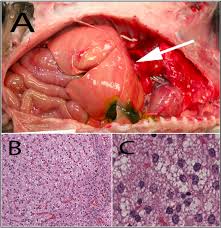Fatty liver disease, or hepatic lipidosis, is a serious condition in dogs characterized by the excessive accumulation of fat in the liver cells. While more commonly associated with cats, this condition can also affect dogs, particularly those who are overweight or have experienced a sudden loss of appetite.
Hepatic lipidosis occurs when the liver is overwhelmed by fat due to an imbalance in the metabolism of fats and proteins. The liver’s inability to process this fat leads to impaired liver function and, if left untreated, can result in liver failure.
Table of Contents
ToggleCauses:
- Obesity: Overweight dogs are at a higher risk as their bodies have a larger fat reserve that can be mobilized into the liver.
- Sudden Weight Loss: When a dog stops eating or experiences a rapid decrease in food intake, the body starts breaking down fat stores too quickly, overwhelming the liver.
- Underlying Diseases: Conditions like diabetes mellitus, pancreatitis, or gastrointestinal diseases can lead to hepatic lipidosis.
- For the treatment of Ear mites in Dogs Click Here.
Clinical Signs of Fatty Liver Disease:
- Loss of Appetite: One of the first signs may be a significant decrease in appetite or refusal to eat.
- Lethargy: Dogs may become unusually tired or inactive.
- Vomiting: Frequent vomiting can occur due to liver dysfunction.
- Jaundice: Yellowing of the eyes, gums, or skin is a clear sign of liver issues.
- Weight Loss: Rapid weight loss, especially in overweight dogs, can indicate hepatic lipidosis.
- Abdominal Discomfort: Dogs may show signs of pain or discomfort in the abdominal area.

Diagnosis:
Diagnosis typically involves blood tests to assess liver function, imaging studies like ultrasound to visualize the liver, and sometimes a liver biopsy to confirm the presence of fat in the liver cells.
Treatment of Fatty Liver Disease:
- Nutritional Support: The primary treatment is to restore proper nutrition, often through a high-protein, high-calorie diet.
- Intravenous Fluids: IV fluids may be necessary to manage dehydration and electrolyte imbalances.
- Medications: Depending on the underlying cause, medications to support liver function or treat concurrent diseases may be prescribed.
- Feeding Tube: In severe cases, a feeding tube may be required to ensure adequate nutrition.
Prevention:
- Weight Management: Keeping your dog at a healthy weight through proper diet and regular exercise is crucial.
- Regular Check-ups: Regular veterinary visits can help detect early signs of liver disease.
- Monitor Appetite: Pay attention to any changes in your dog’s eating habits and seek veterinary advice if they lose their appetite.
- For more details click here.
Conclusion:
Fatty liver disease in dogs is a serious but manageable condition. By understanding the risk factors, signs, and treatment options, pet owners can take proactive steps to protect their dogs’ liver health. Regular veterinary care and attention to dietary habits are key in preventing hepatic lipidosis.
FAQs:
- Can hepatic lipidosis be reversed?
- Yes, with early detection and proper treatment, hepatic lipidosis can be managed and reversed.
- Is hepatic lipidosis common in dogs?
- It is less common in dogs than in cats, but it can occur, especially in dogs with underlying health issues.
- What is the prognosis for a dog with fatty liver disease?
- The prognosis varies depending on the severity and the underlying cause but can be good with prompt treatment.

